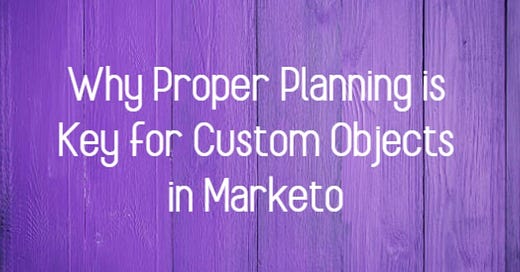Why Proper Planning is Key for Custom Objects in Marketo
When working with Marketo Engage, Custom Objects are a powerful tool for extending the platform’s functionality and tailoring it to your business needs. They enable you to store and access data that isn’t native to Marketo's standard objects, providing flexibility in how you manage your marketing data. However, before rushing through the creating custom object, it’s crucial to plan and define your Custom Objects correctly from the outset.
In this post, we’ll discuss why taking the time to carefully design your Custom Object is essential for maintaining data contiguity and avoiding performance issues.
Why Careful Planning Is Essential When Creating Custom Objects
When you first design your Custom Object, it’s tempting to jump in and make adjustments as you go. However, this approach can create challenges down the line. The reason for this is data contiguity, which plays a critical role in how efficiently Marketo Engage retrieves and handles data.
When you approve a Custom Object in Marketo, the system creates a table in its database based on your initial object definition. This table contains all of the fields and columns that you’ve specified. At this stage, ensuring that you have all necessary fields defined correctly is crucial. Here’s why:
Data Contiguity Matters: If you add fields to the object after it has been approved, Marketo doesn't simply update the original table. Instead, any new fields or columns will be stored in a separate table.
Performance Impact: This setup means that Marketo will need to perform a join operation between tables whenever it accesses the Custom Object. While this might seem like a minor inconvenience, it can significantly impact data retrieval speed, especially for large datasets or complex queries.
The Cost of Modifying Custom Objects After Approval
What happens if you realize later on that you need additional fields in your Custom Object? While it is technically possible to add fields to an already approved object, it’s not without consequences:
Data Storage in Multiple Tables: As mentioned, any new columns will reside in a separate table from the original object definition. This creates a fragmented data structure, with some fields stored in the original table and others in a new one.
Impact on Script Execution and API Performance: Marketo's need to perform joins between tables when accessing this data can slow down script execution times, affect API calls, and even degrade the user experience in the Marketo web interface.
Affects on User Experience: Users working within the Marketo UI may experience delays when retrieving or interacting with data from these Custom Objects. In a fast-paced marketing environment, this can be a roadblock to efficiency.
Avoiding Data Fragmentation: Plan Ahead
So, how can you avoid the hassle of managing data across multiple tables? The answer lies in proper planning during the initial design of your Custom Object:
Define Your Data Requirements Early: Before approving your Custom Object, take the time to understand the data that you will need to store. Consider what attributes or information will be necessary for your marketing operations and ensure all required fields are accounted for.
Consult With Stakeholders: Make sure to consult with team members or stakeholders who will be using the data. Their input can help ensure that the Custom Object is designed with all relevant fields from the outset.
Think Long-Term: Consider how your data needs might evolve over time. Even if you don’t immediately need a certain field, it could be beneficial to include it if you anticipate needing it later. This can save you from having to make adjustments after approval.
Alternative Solutions and Their Drawbacks
If you do find yourself needing additional fields after the initial approval, there are a few alternatives, but each comes with its own set of challenges:
Deleting and Recreating the Custom Object: One option is to delete the Custom Object and recreate it with the correct columns. While this will result in a single, contiguous table, it comes with the added complexity of needing to migrate the data from the old Custom Object to the new one. For most users, this is a time-consuming process and introduces a risk of data loss or errors during migration.
Working with Fragmented Data: The other option is to live with the existing structure and work around the performance challenges. This might be feasible for smaller datasets or less complex operations, but it can become problematic as your marketing database grows and the demand for quick data access increases.
For most businesses, these alternatives add a level of complexity that is best avoided. Thus, the most efficient path forward is to get your Custom Object design right from the start.
TL;DR: When designing Custom Objects in Marketo Engage, take the time to define all necessary fields before approving the object. This ensures data contiguity, with all data stored in a single table, avoiding performance issues caused by fragmented data across multiple tables. Adding fields later can slow down data retrieval and scripts, making it harder to manage. It’s best to plan ahead and get it right the first time to avoid complex data migration or performance bottlenecks.
Happy Marketo’ing! 💜



